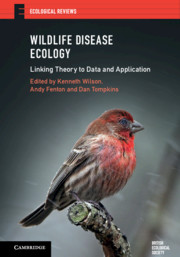Book contents
- Wildlife Disease Ecology
- Ecological Reviews
- Wildlife Disease Ecology
- Copyright page
- Contents
- Contributors
- Preface: Wildlife Disease Ecology
- Glossary of Terms
- Part I Understanding within-host processes
- Part II Understanding between-host processes
- Part III Understanding wildlife disease ecology at the community and landscape level
- Chapter Fifteen The ecological and evolutionary trajectory of oak powdery mildew in Europe
- Chapter Sixteen Healthy herds or predator spreaders? Insights from the plankton into how predators suppress and spread disease
- Chapter Seventeen Multi-trophic interactions and migration behaviour determine the ecology and evolution of parasite infection in monarch butterflies
- Chapter Eighteen When chytrid fungus invades: integrating theory and data to understand disease-induced amphibian declines
- Chapter Nineteen Ecology of a marine ectoparasite in farmed and wild salmon
- Chapter Twenty Mycoplasmal conjunctivitis in house finches: the study of an emerging disease
- Chapter Twenty-one Processes generating heterogeneities in infection and transmission in a parasite–rabbit system
- Chapter Twenty-two Sylvatic plague in Central Asia: a case study of abundance thresholds
- Index
- Plate Section (PDF Only)
- References
Chapter Fifteen - The ecological and evolutionary trajectory of oak powdery mildew in Europe
from Part III - Understanding wildlife disease ecology at the community and landscape level
Published online by Cambridge University Press: 28 October 2019
- Wildlife Disease Ecology
- Ecological Reviews
- Wildlife Disease Ecology
- Copyright page
- Contents
- Contributors
- Preface: Wildlife Disease Ecology
- Glossary of Terms
- Part I Understanding within-host processes
- Part II Understanding between-host processes
- Part III Understanding wildlife disease ecology at the community and landscape level
- Chapter Fifteen The ecological and evolutionary trajectory of oak powdery mildew in Europe
- Chapter Sixteen Healthy herds or predator spreaders? Insights from the plankton into how predators suppress and spread disease
- Chapter Seventeen Multi-trophic interactions and migration behaviour determine the ecology and evolution of parasite infection in monarch butterflies
- Chapter Eighteen When chytrid fungus invades: integrating theory and data to understand disease-induced amphibian declines
- Chapter Nineteen Ecology of a marine ectoparasite in farmed and wild salmon
- Chapter Twenty Mycoplasmal conjunctivitis in house finches: the study of an emerging disease
- Chapter Twenty-one Processes generating heterogeneities in infection and transmission in a parasite–rabbit system
- Chapter Twenty-two Sylvatic plague in Central Asia: a case study of abundance thresholds
- Index
- Plate Section (PDF Only)
- References
Summary
Erysiphe alphitoides causes oak powdery mildew, an example of disease in a wild perennial plant that has shown dramatic changes over a century in Europe. There are several hypotheses for this: pathogen evolution towards lower virulence, a reciprocal increase in oak population resistance, and environmental factors. We show that understanding the pathosystem requires accounting of both seasonality and the occurrence of a pathogen complex, with several cryptic fungal species differing in their life-history traits. Observational data suggest that severity of annual epidemics is linked to interannual pathogen transmission, including winter survival and the infection success of the primary inoculum in spring. Climate-driven phenological synchrony between host and pathogen in spring appears to be critical. Several cryptic Erysiphe species are associated with the disease and co-occur at multiple spatial scales. A semi-discrete model combining a SIR model in the epidemic phase and a discrete-time model between years, based on a within–between season transmission trade-off, describes seasonality and the coexistence of pathogen species. We discuss model refinement by the introduction of host population age classes and other modelling approaches for the evolution of pathogen virulence and host resistance in a changing environment.
Keywords
- Type
- Chapter
- Information
- Wildlife Disease EcologyLinking Theory to Data and Application, pp. 429 - 457Publisher: Cambridge University PressPrint publication year: 2019
References
- 8
- Cited by



